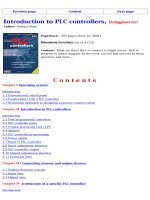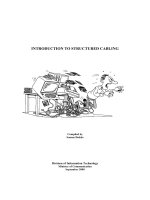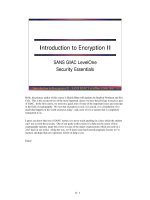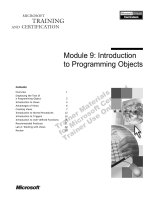Introduction to XSLT Concepts doc
Bạn đang xem bản rút gọn của tài liệu. Xem và tải ngay bản đầy đủ của tài liệu tại đây (899.76 KB, 56 trang )
Introduction to XSLT Concepts
Deborah Aleyne Lapeyre and B. Tommie Usdin
Mulberry Technologies, Inc.
17 West Jefferson St., Suite 207
Rockville, MD 20850
Phone: 301/315-9631
Fax: 301/315-8285
January 2006
©2006 Mulberry Technologies, Inc.
Introduction to XSLT Concepts
Administrivia 1
What is XSLT 4
What XSLT Does is “Transform” 5
The Very Basics of XSLT Transforms 6
Sample XSLT Transforms
Logical Components of an XSLT Application 9
Component 1: XML Document 10
Looking at an XML Document as a Tree 11
Component 2: The XSLT Stylesheet (aka XSLT Transform) 11
An XSL Stylesheet / Transform 13
Component 3: An XSLT Engine/Processor 14
Component 4: The Output File(s) 16
Watching a Stylesheet in Operation
How Input-Driven Stylesheets Work 16
Advice: What to Do and Not Do with XSLT 17
Business Uses XSLT Because XML is Everywhere 17
For the Right Kind of Problems* … 17
What’s Really Easy in XSLT 18
XSLT Easily Changes XML into Different XML 18
XSLT Handles Markup Well 18
XSLT is Not Good at Everything 19
XSLT is Weak on Manipulating Text (Strings) 19
Really Big Files 21
Making Flat Files into Hierarchies 21
Where XSLT Fits in Processing 22
How Organizations Use XSLT 23
Simple Business Transforms 23
Making HTML From Semantically Richer XML 24
Page i
Introduction to XSLT Concepts
Single Source and Reuse Publishing 25
Construct the Output for Publishing 25
What You Want in the Order You Want It 26
There is Not Just One Print Product 26
Some of the Text is Added by the Transform 27
Large Structures Can be Built and Inserted as Well 27
XSLT is Also Useful During Production 28
XML for Interchange and Archiving 30
XSLT as the Middle Component in XSL-FO 30
How XSL-FO Works 31
Architecture of a Full XSL System (XSLT + XSL-FO) 32
Formatting Objects Describe Page Layout 32
Applying Styles through XSL FOs 33
XSL-FO is a Great Report Writer 33
The Last Bits 34
What is XPath 34
XPath Has Two Main Uses 35
You’ve Seen XPath in match Expressions 35
XPath Can Be Very Complex 35
Another Complexity: Push-me Pull-you Stylesheets
What is a Pull Stylesheet? 37
Why Pull Can Be a Problem 40
Heads UP: XSLT and XPath 1.0, 1.1, 2.0 41
What Was “Wrong” with XSLT 1.0 41
XSLT 2.0: More Power; More Programmer Responsibility 42
How to Deal with XSLT 1.0 and 2.0 (November 2005) 42
How to Make XSLT Programmers 43
XSLT is Also Really Easy But 43
How to Learn XSLT 45
Debbie's XSLT Programming Pearls (Optional) 45
Page ii
Introduction to XSLT Concepts
Now Let’s Look at Some Real Stylesheets 46
End Speech; Start References
For Further Information 47
XSLT Technical Reference Book 47
Useful XSLT Reference Website: Zvon 48
XSLT Concept/Syntax Books 48
XSLT Syntax+ for Programmers 48
Colophon 49
Appendixes
Appendix 1: Representative XSLT Tools 49
Appendix 2: Acronyms Used in This Talk 50
Page iii
Introduction to XSLT Concepts
slide 1
Administrivia
C
Start, end, break
C
Ask questions any time (please!)
C
Who we are
C
Why this class
C
Why more publishing examples
C
Anything else?
slide 2
Where We Are
Not
Going in This Tutorial
C
What is XML, why you should care, how XML works
(element, attribute, DTD, schema, entity)
C How to solve your particular business problem(s)
C Programmer stuff like how to write stylesheets
(although you will see some code)
C Syntax of the XSLT language (templates, functions, location paths)
C Detailed XPath syntax (location paths, functions, data types)
C XSLT tools
C XSL-FO in depth (that’s this afternoon)
Page 1
Introduction to XSLT Concepts
slide 3
Where We Are Going Today
The What and Why of XSLT
C
What is transformation, what is XSLT
C
How it works (logical components of an XSLT system)
C
How to think about it (the XSLT processing model)
C
How businesses are using XSLT
C
What XSLT does not do well
C
How should you learn/write XSLT
slide 4
WARNING!
We are going to show code!
You’ll understand the examples even if you ignore the code
We are going to act as if you never heard of XSLT and start from scratch
Page 2
Introduction to XSLT Concepts
slide 5
A Quick Poll (Who You Are)
C
Where in the process
C
content creators / editors / publishers
C
prepress / composition
C
printers
C
print / web / graphic design
C
fulfillment / distribution
C
System analysts / application programmers
C
Training
C
What kind of publishing
C
Books (monographs, reference series, etc.)
C
Journals
C Magazines and newspapers
C Product documentation
C Technical documentation
C Course materials (CBT, course-packages, tests, textbooks plus, etc.)
C Non-publishing folks
Page 3
Introduction to XSLT Concepts
slide 6
What Do You Know Now?
C
Know HTML (even a little)
C
XML
C
SGML
C
XSLT
C
XSL-FO
C
Microsoft Word, WordPerfect
C
QuarkXPress, InDesign, other desktop publishing
C
High-end composition systems
slide 7
What is XSLT
Extensible Stylesheet Language Transformation
C Name is misleading
C Stylesheet
C implies it makes things look like something
C not necessarily or usually true
C Name should have been
“The XML Transformation Language”
Page 4
Introduction to XSLT Concepts
slide 8
So What is XSLT Really?
C
Provides transformation and manipulation functions for XML files
C
Designed to make XML into something else
C
1.0 W3C Recommendation 1999
C 2.0 Candidate Recommendation November 2005
slide 9
What XSLT Does is “Transform”
Transform means change
Reads XML documents and writes
C
HTML for browsers
C a different XML tag set
C typesetting driver file (InDesign, QuarkXPress, FrameMaker)
C interchange file (RTF, RDF, EDI, etc.)
C a flat ASCII file (plain text, comma separated etc.)
Page 5
Introduction to XSLT Concepts
slide 10
The Very Basics of XSLT Transforms
C
Transform
C
does not change the input file
C
creates one (or more) new output files
C
Transform does not make something else into XML
C
Two basic requirements
C
known XML source (tag set, schema, DTD)
C
known target
Sample XSLT Transforms
slide 11
Take in an XML document
<employee-record type="dog" empno="9">
<name>
<first>Sasparilla</first>
<last>Usdin</last></name>
<affiliation>
<title>Deputy in Charge of Chewables</title>
<company>Mulberry Technologies</company>
<location><city>Rockville</city>
<state>MD</state><zip>20850</zip></location>
<email-name>sassy</email-name>
</affiliation>
<height unit="in">36</height><weight unit="lb">70</weight>
</employee-record>
Page 6
Introduction to XSLT Concepts
slide 12
Transform It into HTML
(convert to HTML and display in a browser)
slide 13
Transform It into PDF
(convert to PDF and display with Acrobat)
Page 7
Mulberry
Technolo
g
ies, Inc.
Sasparilla Usdin
17 West Jefferson Street
Suite 207
Rockville, MD 20850
Phone: 301/315-9631
Fax: 301/315-9634
Introduction to XSLT Concepts
slide 14
Transform It into QuarkXPress
C
XML elements rolled into “form letter”
C Something (perhaps employee-id) linked to photo
slide 15
Transform It into a Database Load File
Key: 00095AUS
EMPNO: 009
001:USDIN
002:Sasparilla
008:36
014:70
020:Deputy in Charge of Chewables
Page 8
Sasparilla Usdin
has recently joined Mulberry Technologies, Inc.’s
Rockville staff as Deputy in Charge of Chewables.
Welcome to the team, Sassy!
Introduction to XSLT Concepts
slide 16
In Other Words: Tagging Changes Large and Small
C
Change the following
<surname>Lapeyre</surname>
<firstnames>Deborah A.</firstnames>
INTO
<contrib>Deborah A. Lapeyre</contrib>
C
Change the following
<chapter><title>Lawns and Gardens</title>
INTO
<h2>Lawns and Gardens</h2>
C <bold>Tall</bold>
INTO
:G46Helvetica-ExtraBold;Tall
slide 17
Logical Components of an XSLT Application
(needs XSLT processing software (called an “XSLT Engine”)
C Reads XML document(s) (tags and text)
C Uses an XSLT stylesheet/transform (the program)
C Runs using XSLT processing software (called an XSLT Engine)
C Produces output document(s)
Page 9
Structure of an XSLT System
XSLT
stylesheet
XSLT
processor
output
file
XML
file
Introduction to XSLT Concepts
slide 18
Component 1: XML Document
C
XML documents
C
are sequences of data characters and markup
C
start-tag and end-tag markup delimits elements
C
But XSLT does not work directly on XML documents
C
Part of the XSLT processing (usually an XML parser)
builds a tree
C
XSLT works on trees (made from XML documents)
Page 10
Introduction to XSLT Concepts
slide 19
Looking at an XML Document as a Tree
slide 20
Component 2: The XSLT Stylesheet
(aka XSLT Transform)
C A computer program
C Transformation instructions
C Called a “stylesheet” (or a “transform”)
C A well-formed XML document!
C Commands in the XSLT language are
C a tag set (elements and attributes)
C defined by the W3C XSLT recommendation
C that look like this (<xsl:sort> and <xsl:number>)
Page 11
Introduction to XSLT Concepts
slide 21
An XSLT Stylesheet / Transform Is
C
A series of rules (called template rules)
C
Each rule is a sequence of XSLT commands
C
Each command is an XML element with attributes
C
A rule is executed when it
C
matches some condition
C
or is called by name
slide 22
“Matching a Condition” Means
C
If you find a (________) in the source XML,
then do this (perform the template)
C Matching can mean finding in the XML
C an element
C an element/attribute combination
C an element in a certain context
C some special circumstance
(words in the content, any element at all, etc.)
Page 12
Introduction to XSLT Concepts
slide 23
An XSL Stylesheet / Transform
(close your eyes, this is code)
C
Here is a template rule
C
This rule matches a <paragraph> element
C
Notice that it is made up of XML elements (two kinds)
C
The two kinds of XML elements
C
XSLT language tags (instructions)
C
HTML tags
1 <xsl:template match="paragraph">
2
<hr/>
3
<p>
4 <xsl:apply-templates/>
5
</p>
6 </xsl:template>
Page 13
Introduction to XSLT Concepts
slide 24
Component 3: An XSLT Engine/Processor
C
You need special software to run XSLT
C
But you don’t have to buy them
C
Free open-source, shareware, as well as commercial
C
New ones all the time
C
Look for more at:
C
Saxon ( )
C Xalan XSLT ( )
C Unicorn XSLT Processor
( )
C XSLT C library for Gnome ( )
slide 25
XSLT Also Built Into/Can be Hooked Into
C XML programmers’ developing environments
C XML-aware editors
C Content aggregation systems
C Other XML processors
In softwares like this XSLT comes built in and you still don’t have to buy it!
Page 14
Introduction to XSLT Concepts
slide 26
How an XSLT Processor Works
The big dark rectangle above is the XSLT processor
Page 15
Result
Tree
Source
Tree
T
r
a
n
s
f
o
r
m
e
r
<z>XSL is <e>fun</e></z>
<t>XSL is </t>"fun"
<xsl:stylesheet>
</xsl:stylesheet>
Introduction to XSLT Concepts
slide 27
Component 4: The Output File(s)
XSLT can make 3 syntaxes for output
C
XML files
C
HTML
C
Text (untagged files)
C
ASCII email message
C
comma-separated file
C
desktop publishing system format (e.g., XTags for QuarkXPress)
Watching a Stylesheet in Operation
slide 28
How Input-Driven Stylesheets Work
Page 16
Introduction to XSLT Concepts
slide 29
Advice: What to Do
and Not Do
with XSLT
slide 30
Business Uses XSLT Because XML is Everywhere
C
XSLT was designed to process XML
C
Takes full advantage of the tree
C
XML constructs are built in ( no special programming)
C
Solves problems with
C
order of the material
C
document model/processing mismatch
C
interchange (mine different from yours different from ours)
C personalization/localization
C Part of the XML family, so applications built to support
Makes content fluid, as XML
and SGML have always promised
slide 31
For the
Right Kind of Problems
* …
XSLT is
C faster
C better
C cheaper
*All three, but note the caveat
Page 17
Introduction to XSLT Concepts
slide 32
What’s
Really
Easy in XSLT
C
Extract just some of the input
C
Change sequence of elements (rearrange / sort)
C
Remove material
C
Use the same element / attribute in 5 places
C
Add generated text
slide 33
XSLT Easily Changes XML into Different XML
C
Rename an element or attribute
C
Change element xxx into element yyy
C
Make elements into attributes
C Make attributes into elements
slide 34
XSLT Handles Markup Well
XSLT works best when
C What you care about (want to process) is tagged!
C Hierarchy is explicit
C The most important relationships are tree relationships
C containment (parent / child)
C siblings
C attributes
Page 18
Introduction to XSLT Concepts
slide 35
XSLT is
Not
Good at Everything
C
Not at all
C
conversion into XML
C
Non-XML data (Word, QuarkXPress, SGML)
C
Not as good as most “programming languages”
C
number crunching (arithmetic and higher math)
C
string processing (parsing)
C
really big files
C
making structure where there was none
(making flat files into hierarchies)
slide 36
XSLT is Weak on Manipulating Text (Strings)
C An XSLT processor expects to work on
C a tree of nodes
C not an XML file of tags and text
C If you have untagged files
(comma delimited, space delimited, tab delimited)
C there is no tree
C strings must be “parsed” into pieces
C XSLT does this awkwardly
(XSLT 2.0 has better string manipulation than XSLT 1.0, but…)
Page 19









